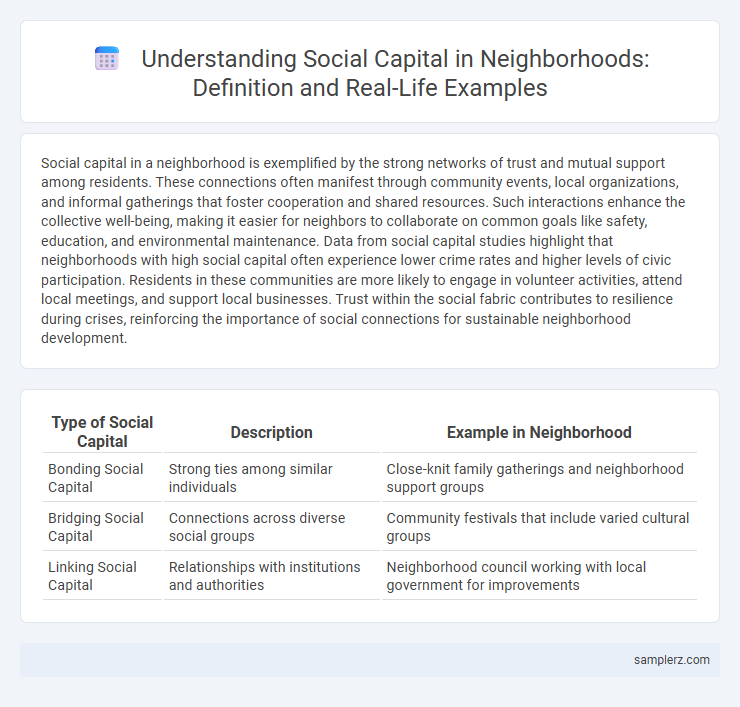Social capital in a neighborhood is exemplified by the strong networks of trust and mutual support among residents. These connections often manifest through community events, local organizations, and informal gatherings that foster cooperation and shared resources. Such interactions enhance the collective well-being, making it easier for neighbors to collaborate on common goals like safety, education, and environmental maintenance. Data from social capital studies highlight that neighborhoods with high social capital often experience lower crime rates and higher levels of civic participation. Residents in these communities are more likely to engage in volunteer activities, attend local meetings, and support local businesses. Trust within the social fabric contributes to resilience during crises, reinforcing the importance of social connections for sustainable neighborhood development.
Table of Comparison
| Type of Social Capital | Description | Example in Neighborhood |
|---|---|---|
| Bonding Social Capital | Strong ties among similar individuals | Close-knit family gatherings and neighborhood support groups |
| Bridging Social Capital | Connections across diverse social groups | Community festivals that include varied cultural groups |
| Linking Social Capital | Relationships with institutions and authorities | Neighborhood council working with local government for improvements |
Building Trust Among Neighbors
Building trust among neighbors enhances social capital by fostering open communication, mutual support, and shared norms within a community. Regular neighborhood activities, such as block parties or community clean-ups, create opportunities for residents to establish reliable relationships and collective responsibility. This trust encourages collaboration on safety initiatives and resource sharing, leading to a stronger, more resilient neighborhood network.
Community Watch Programs
Community Watch Programs exemplify social capital by fostering trust, cooperation, and mutual support among neighbors to enhance safety and reduce crime rates. These programs rely on active participation, shared norms, and collective responsibility, which strengthen social networks and encourage communication across diverse groups. Enhanced social ties within Community Watch initiatives contribute to resilient neighborhoods with improved well-being and crime prevention outcomes.
Neighborhood Volunteer Groups
Neighborhood volunteer groups strengthen social capital by fostering trust, cooperation, and mutual support among residents. These groups organize community clean-ups, safety patrols, and local events that encourage neighborly interaction and collective problem-solving. Active participation in volunteer groups enhances social networks, leading to improved community resilience and shared resources.
Shared Childcare Networks
Shared childcare networks strengthen social capital in neighborhoods by fostering trust and cooperation among residents. These networks enable parents to exchange childcare responsibilities, creating reliable support systems that enhance community resilience. Such collaborative arrangements improve communication, deepen social ties, and increase collective efficacy in local environments.
Local Support During Emergencies
Local support during emergencies exemplifies social capital in neighborhoods through neighbors sharing resources, offering shelter, and providing emotional assistance. This collective action enhances community resilience and accelerates recovery after crises such as natural disasters or power outages. Strong social ties foster trust and cooperation, enabling efficient mobilization of help when urgent needs arise.
Community Gardening Initiatives
Community gardening initiatives foster social capital by creating shared spaces where neighbors collaborate, exchange resources, and build trust. These projects enhance social cohesion and collective efficacy, contributing to safer, more connected neighborhoods. Participation in community gardens also facilitates intergenerational interactions and cultural exchange, strengthening community identity.
Organizing Neighborhood Events
Organizing neighborhood events strengthens social capital by fostering trust, cooperation, and a sense of community among residents. Activities such as block parties, clean-up drives, and local festivals create opportunities for social interaction, enhancing mutual support and collective efficacy. These events contribute to building resilient neighborhoods where individuals are more likely to collaborate on shared goals and community improvement.
Informal Lending and Borrowing
Informal lending and borrowing within neighborhoods exemplify social capital by fostering trust and reciprocal relationships among residents. These exchanges, often involving money, tools, or other resources, strengthen community bonds and provide crucial support during financial hardships. Such practices reduce reliance on formal institutions, enhancing resilience and social cohesion at the local level.
Mutual Aid for Elderly Residents
Mutual aid for elderly residents strengthens neighborhood social capital by fostering trust, cooperation, and resource sharing among community members. Examples include volunteer-run meal delivery programs, neighborhood watch groups, and grassroots transportation services for seniors. These initiatives enhance social cohesion and ensure vulnerable populations receive necessary support within their local environment.
Collaborative Problem Solving
Neighborhood social capital thrives through collaborative problem solving, where residents jointly address local issues such as safety, cleanliness, and community events. By forming committees or neighborhood watch groups, citizens pool resources and knowledge, enhancing trust and shared responsibility. This collective action strengthens social networks, fostering resilience and improving overall quality of life.

example of social capital in neighborhood Infographic
 samplerz.com
samplerz.com